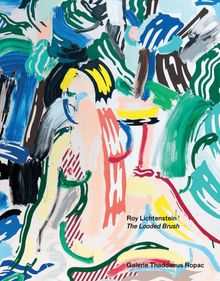ARTIST MONOGRAPHS
|
|
STATUS: Out of stock Temporarily out of stock pending additional inventory. |
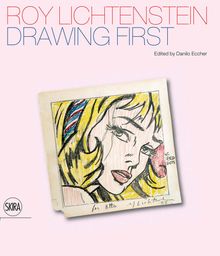 Roy Lichtenstein: Drawing First
Roy Lichtenstein: Drawing First
50 Years of Works on Paper
Published by Skira.
By Danilo Eccher.
Written in close collaboration with the Roy Lichtenstein Estate and Foundation, this monograph presents an extraordinary selection of over 200 works on paper by the American artist, from the National Gallery of Washington, DC; the MoMA and the Whitney Museum, New York; the Art Institute of Chicago, as well as public and private European and American collections. Devoted to his works on paper that represent the most private and poetic aspect of Roy Lichtenstein’s production, this volume provides the reader with a unique perspective for getting to know and appreciate the artist’s oeuvre through the “first works,” namely the original ideas that were to be the source of inspiration for his great, world-famous masterpieces. The works on paper are also paired with some important paintings and sculptures, as well as a rich selection of photographs documenting the artist at work.
The volume includes texts by Danilo Eccher, Dorothy Lichtenstein, Bernice Rose, Jack Cowart, Thomas Zacharias (“Lichtenstein Draws”), and Andrea C. Theil, a chronology (by Clare Bell), and a list of exhibitions in Italy.
Danilo Eccher is the director of the Galleria d’Arte Moderna, Turin.
PUBLISHER
Skira
BOOK FORMAT
Hardcover, 9.75 x 11.5 in. / 264 pgs / 300 color.
PUBLISHING STATUS
Pub Date 11/3/2015
Out of stock indefinitely
DISTRIBUTION
D.A.P. Exclusive
Catalog: Publisher Backlist
PRODUCT DETAILS
ISBN 9788857226941 TRADE
List Price: $60.00 CAD $78.00
AVAILABILITY
Not available
STATUS: Out of stock indefinitely. |
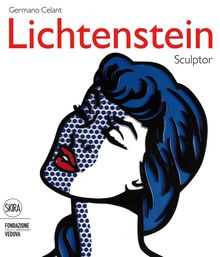 Roy Lichtenstein Sculptor
Roy Lichtenstein Sculptor
Published by Skira.
Edited by Germano Celant. Text by Clare Bell, Richard Calvocoressi.
An exceptional selection of Lichtenstein’s sculptures from 1968 to the end of the artist’s life, from early ceramic sculptures to large-scale public works. The planned exhibition at the Fondazione Vedova in Venice (Biennale Arte 2013) will encompass Roy Lichtenstein’s sculptural production throughout his career, from the early 1960s through the late 1990s, covering the influential artist’s sculptural œuvre in ceramic, bronze, wood, porcelain, steel, and aluminum, as well as drawings, collages, and maquettes that describe the artist’s working processes. This catalog—a major chronology of Lichtenstein’s sculptures—not only documents the process of the artist, from sketches and drawings to collages, maquettes, metal sculptures, and large-scale interventions in urban contexts, it also approaches Lichtenstein’s work from the perspective of fabrication methods and industrial techniques.
Internationally known for his writings on Arte Povera, Germano Celant has been a contributing editor at Artforum since 1977 and at Interview since 1991. Clare Bell is program manager and researcher at ths Roy Lichtenstein Foundation. Richard Calvocoressi is director of the Henry Moore Foundation.
PUBLISHER
Skira
BOOK FORMAT
Hardcover, 10 x 11.75 in. / 320 pgs / 235 color.
PUBLISHING STATUS
Pub Date 11/5/2013
Active
DISTRIBUTION
D.A.P. Exclusive
Catalog: Publisher Backlist
PRODUCT DETAILS
ISBN 9788857218892 TRADE
List Price: $90.00 CAD $115.00
AVAILABILITY
In stock
in stock $90.00 Free Shipping UPS GROUND IN THE CONTINENTAL U.S. |
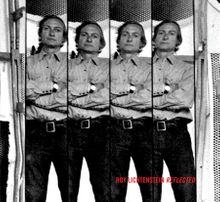 Roy Lichtenstein Reflected
Roy Lichtenstein Reflected
Published by Mitchell-Innes & Nash.
Text by Graham Bader, David Salle.
PUBLISHER
Mitchell-Innes & Nash
BOOK FORMAT
Hardcover, 11 x 10 in. / 64 pgs / 47 color.
PUBLISHING STATUS
Pub Date 3/31/2011
Active
DISTRIBUTION
D.A.P. Exclusive
Catalog: SPRING 2011 p. 126
PRODUCT DETAILS
ISBN 9780981457864 TRADE
List Price: $40.00 CAD $54.00 GBP £35.00
AVAILABILITY
In stock
in stock $40.00 Free Shipping UPS GROUND IN THE CONTINENTAL U.S. |
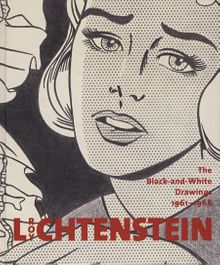 Roy Lichtenstein: The Black-and-White-Drawings 1961-1968
Roy Lichtenstein: The Black-and-White-Drawings 1961-1968
Published by Hatje Cantz.
Text by Isabelle Dervaux, Graham Bader, Clare Bell, Lindsey Tyne.
PUBLISHER
Hatje Cantz
BOOK FORMAT
Hardcover, 9.75 x 11.75 in. / 208 pgs / 150 col.
PUBLISHING STATUS
Pub Date 11/30/2010
Out of print
DISTRIBUTION
D.A.P. Exclusive
Catalog: FALL 2010 p. 93
PRODUCT DETAILS
ISBN 9783775726436 TRADE
List Price: $60.00 CAD $70.00
AVAILABILITY
Not available
STATUS: Out of print | 00/00/00 For assistance locating a copy, please see our list of recommended out of print specialists |
 Roy Lichtenstein
Roy Lichtenstein
Published by The Museum of Modern Art, New York.
Text by Carolyn Lanchner.
PUBLISHER
The Museum of Modern Art, New York
BOOK FORMAT
Paperback, 6 x 8 in. / 48 pgs / 40 color.
PUBLISHING STATUS
Pub Date 10/31/2009
Active
DISTRIBUTION
D.A.P. Exclusive
Catalog: FALL 2009 p. 42
PRODUCT DETAILS
ISBN 9780870707704 TRADE
List Price: $9.95 CAD $14.95
AVAILABILITY
Out of stock
STATUS: Out of stock Temporarily out of stock pending additional inventory. |
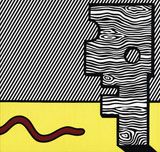 Roy Lichtenstein: Conversations With Surrealism
Roy Lichtenstein: Conversations With Surrealism
Published by Mitchell-Innes & Nash.
Essays by Charles Stuckey and Frederic Tuten. Foreword by Jack Cowart.
PUBLISHER
Mitchell-Innes & Nash
BOOK FORMAT
Hardcover, 11 x 10.5 in. / 128 pgs / 70 color / 11 bw.
PUBLISHING STATUS
Pub Date 1/1/2006
Out of print
DISTRIBUTION
D.A.P. Exclusive
Catalog: SPRING 2006 p. 102
PRODUCT DETAILS
ISBN 9780974960746 TRADE
List Price: $60.00 CAD $70.00
AVAILABILITY
Not available
STATUS: Out of print | 00/00/00 For assistance locating a copy, please see our list of recommended out of print specialists |
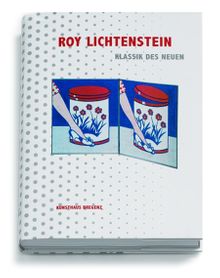 Roy Lichtenstein
Roy Lichtenstein
Published by Kunsthaus Bregenz.
Edited by Eckhard Schneider. Essays by Bob Adelman, Michael Lobel, Siegfried Gohr, Ettore Sottsass, Michael Craig-Martin, Avis Berman and Eva Wattolik. Photo Essay by Bob Adelman.
PUBLISHER
Kunsthaus Bregenz
BOOK FORMAT
Clothbound, 9.5 x 12.75 in. / 248 pgs / 80 color / 20 bw.
PUBLISHING STATUS
Pub Date 10/15/2005
Out of print
DISTRIBUTION
D.A.P. Exclusive
Catalog: FALL 2005
PRODUCT DETAILS
ISBN 9783883759654 TRADE
List Price: $85.00 CAD $100.00
AVAILABILITY
Not available
STATUS: Out of print | 00/00/00 For assistance locating a copy, please see our list of recommended out of print specialists |
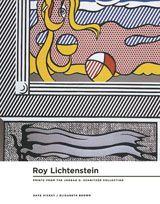 Roy Lichtenstein: Prints 1956-1997
Roy Lichtenstein: Prints 1956-1997
From the Collections of Jordan D. Schnitzer and Family Foundation
Published by Marquand Books/Museum of Art/Washington State University.
Essays by Dave Hickey and Elizabeth Brown. Introduction by Chris Bruce.
PUBLISHER
Marquand Books/Museum of Art/Washington State University
BOOK FORMAT
Hardcover, 8 x 10 in. / 80 pgs / 50 color / 3 bw.
PUBLISHING STATUS
Pub Date 10/15/2005
Out of stock indefinitely
DISTRIBUTION
D.A.P. Exclusive
Catalog: FALL 2005 p. 126
PRODUCT DETAILS
ISBN 9780975566213 TRADE
List Price: $24.95 CAD $33.95 GBP £22.00
AVAILABILITY
Not available
STATUS: Out of stock indefinitely. |
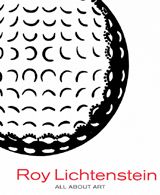 Roy Lichtenstein: All About Art
Roy Lichtenstein: All About Art
Published by Louisiana Museum of Modern Art.
Edited by Michael Juul Holm, Martin Caiger-Smith and Poul Erik TØjner. Essays by Avis Berman, Michael Lobel, Jack Cowart, David Sylvester and Poul Erik TØjner. Introduction by Susan Ferleger Brades.
PUBLISHER
Louisiana Museum of Modern Art
BOOK FORMAT
Hardcover, 10 x 11.5 in. / 144 pgs / 85 color / 18 bw.
PUBLISHING STATUS
Pub Date 3/2/2004
Out of print
DISTRIBUTION
D.A.P. Exclusive
Catalog: SPRING 2004
PRODUCT DETAILS
ISBN 9788790029852 TRADE
List Price: $50.00 CAD $60.00
AVAILABILITY
Not available
STATUS: Out of print | 5/28/2010 For assistance locating a copy, please see our list of recommended out of print specialists |
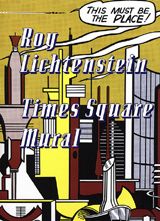 Roy Lichtenstein: Times Square Mural
Roy Lichtenstein: Times Square Mural
Published by Mitchell-Innes & Nash/Roy Lichtenstein Foundation.
Artwork by Roy Lichtenstein. Edited by Rick Moody. Contributions by Jack Cowart. Text by Scott Rothkopf.
PUBLISHER
Mitchell-Innes & Nash/Roy Lichtenstein Foundation
BOOK FORMAT
Paperback, 11 x 15 in. / 100 pgs / 49 color / 15 bw.
PUBLISHING STATUS
Pub Date 2/2/2003
Out of stock indefinitely
DISTRIBUTION
D.A.P. Exclusive
Catalog: SPRING 2003
PRODUCT DETAILS
ISBN 9780971384453 TRADE
List Price: $25.00 CAD $34.50 GBP £22.00
AVAILABILITY
Not available
STATUS: Out of stock indefinitely. |
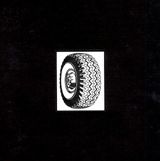 Roy Lichtenstein: Early Black And White Paintings
Roy Lichtenstein: Early Black And White Paintings
Published by Gagosian Gallery.
Essays by Robert Rosenblum and Frederic Tuten.
PUBLISHER
Gagosian Gallery
BOOK FORMAT
Hardcover, 12.25 x 12.25 in. / 60 pgs / 18 color / 24 bw.
PUBLISHING STATUS
Pub Date 7/2/2002
No longer our product
DISTRIBUTION
D.A.P. Exclusive
Catalog: FALL 2002
PRODUCT DETAILS
ISBN 9781880154625 TRADE
List Price: $40.00 CAD $50.00
AVAILABILITY
Not available
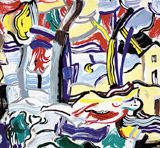 Roy Lichtenstein: Brushstrokes, Four Decades
Roy Lichtenstein: Brushstrokes, Four Decades
Published by Mitchell-Innes & Nash.
Essay by Dave Hickey.
PUBLISHER
Mitchell-Innes & Nash
BOOK FORMAT
Clothbound, 11.5 x 10.25 in. / 86 pgs / 60 color.
PUBLISHING STATUS
Pub Date 2/2/2002
Out of print
DISTRIBUTION
D.A.P. Exclusive
Catalog: SPRING 2002
PRODUCT DETAILS
ISBN 9780971384415 TRADE
List Price: $60.00 CAD $70.00
AVAILABILITY
Not available
STATUS: Out of print | 4/1/2008 For assistance locating a copy, please see our list of recommended out of print specialists |
